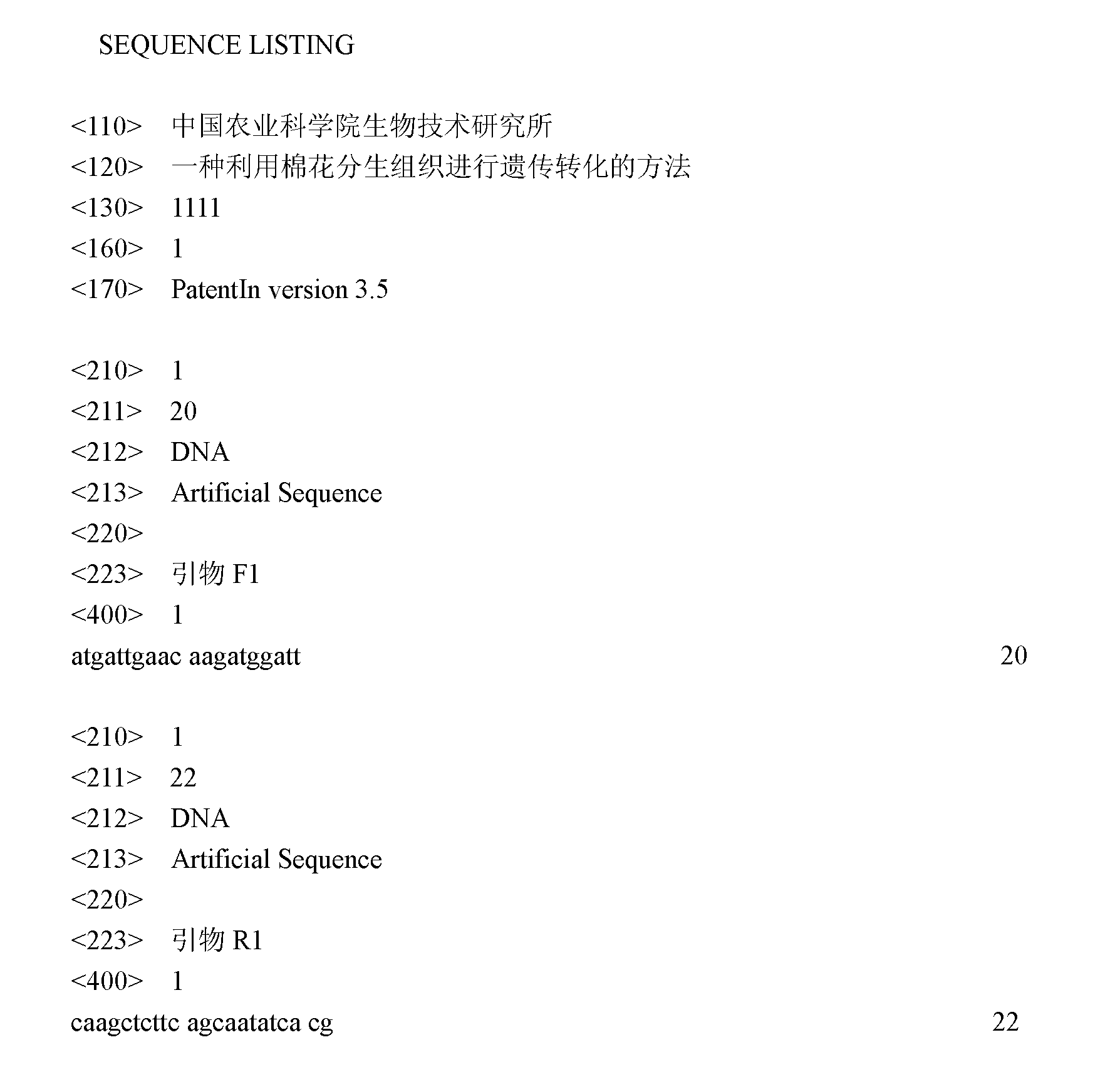Genetic transformation method by utilization of cotton meristematic tissue
A technology of meristem and genetic transformation, applied in the field of genetic transformation using cotton meristem, can solve the problems of low regeneration rate, shorten regeneration time, high frequency of deformed embryos, etc., achieve cost saving, shorten time, and good repeatability Effect
- Summary
- Abstract
- Description
- Claims
- Application Information
AI Technical Summary
Benefits of technology
Problems solved by technology
Method used
Image
Examples
Embodiment 1
[0023] Example 1: Preparation of Agrobacterium Containing Target Gene Plasmid Vector
[0024] 1) Preparation of competent Agrobacterium tumefaciens LBA4404
[0025] (1) Pick a single colony from the plate and inoculate it into 5ml YEB liquid medium (1L YEB medium consists of 1 gram of yeast extract, 5 grams of peptone, 20 grams of sucrose, 0.5 gram of magnesium sulfate 7 hydrate, 125 mg of streptomycin Strep and water, make up the volume with water), shake culture at 28°C and 250rpm overnight.
[0026] (2) Take 2ml of bacterial liquid, add it into 50ml of YEB liquid medium (containing 125mg / L of Strep), shake and cultivate at 28°C and 250rpm until OD600 is about 0.6.
[0027] (3) Transfer the bacterial solution to a 50ml sterile centrifuge tube, place in an ice bath for 30min, and centrifuge at 5000rpm for 5min.
[0028] (4) Discard the supernatant and use 2ml 20mM CaCl for precipitation 2 Resuspend, and distribute 100 μl each into 1.5ml centrifuge tubes, and store in liquid
Embodiment 2
[0034] Example 2: Cotton Genetic Transformation by Agrobacterium-mediated Method Using Meristem
[0035] The recipient variety used was Sumian 12.
[0036] (1) From the end of April to the beginning of May, sow seeds at the Langfang base of the Institute of Biotechnology, Chinese Academy of Agricultural Sciences.
[0037] (2) Activation of Agrobacterium containing the target gene plasmid vector: Pick a single colony of Agrobacterium from the plate, inoculate it into 5ml YEB liquid medium (Kan 100mg / L, Strep 100mg / L, Rif 300mg / L), shake culture Overnight; inoculate 1ml of bacterial liquid into 50ml of YEB liquid medium (Kan 100mg / L, Strep100mg / L, Rif 300mg / L), shake vigorously until OD600 is 0.6-0.8 (about 3-4h); centrifuge at 5,000rpm for 5min , bacteria solution (1 / 2MS inorganic + 1% sucrose + 0.1% Triton X-100 + 0.01% Silwet L-77 + 50mg / l AS) or (1 / 2MS inorganic + 1% sucrose + 0.1% Triton X- 100+0.01% Silwet L-77+50mg / l AS+0.1mm 6-BA) for resuspension, and
Embodiment 3
[0050] Example 3: Molecular detection of transgenic cotton
[0051] Extract the genomic DNA of 16 transgenic cottons obtained by embodiment 2, with F1 (nucleotide sequence shown in SEQ ID No.1) and R1 (nucleotide sequence shown in SEQ ID No.2) as primers ( Primers F1 and R1 were set according to the sequence of the kanamycin resistance gene) for PCR amplification, and the reaction conditions were as follows: first denaturation at 94°C for 4 minutes; then 94°C for 1m, 58°C for 1min, 72°C for 50s, 30 cycles; ℃ extension 5min. With Su Cotton 12 (non-GMO cotton) and ddH 2 O is the negative control, and the plasmid vector pCAMBia2300 containing the kana resistance gene is used as the positive control. PCR product electrophoresis detection, the results are as follows figure 1 As shown, a DNA band of the expected size (about 700 bp) was amplified in lanes 2-16, indicating that the target gene had been transferred into the cotton line.
[0052]
PUM
 Login to view more
Login to view more Abstract
Description
Claims
Application Information
 Login to view more
Login to view more - R&D Engineer
- R&D Manager
- IP Professional
- Industry Leading Data Capabilities
- Powerful AI technology
- Patent DNA Extraction
Browse by: Latest US Patents, China's latest patents, Technical Efficacy Thesaurus, Application Domain, Technology Topic.
© 2024 PatSnap. All rights reserved.Legal|Privacy policy|Modern Slavery Act Transparency Statement|Sitemap


